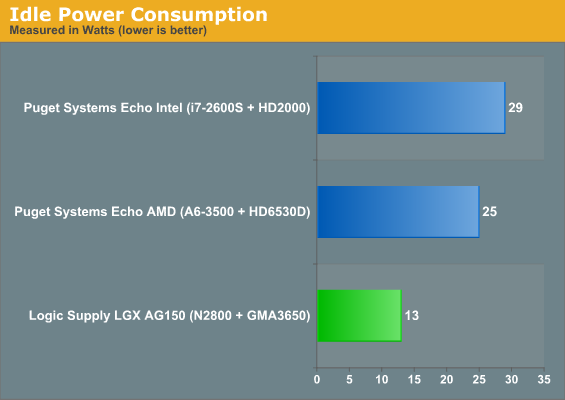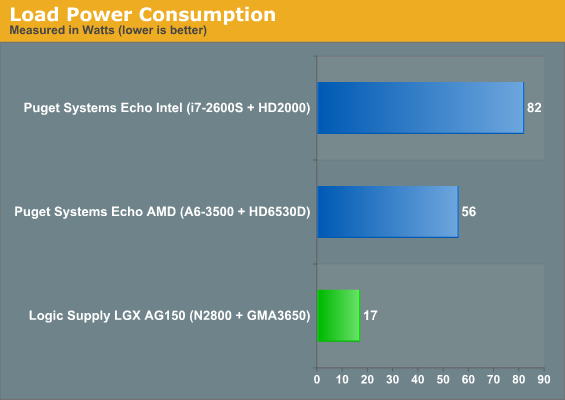Logic Supply LGX AG150 Fanless System Review: Cedar Trail or Cedar Trial?
by Dustin Sklavos on May 28, 2012 11:30 PM EST- Posted in
- kiosk
- Systems
- Atom
- Cedar Trail
User Experience and Power Consumption
Intel's Cedar Trail based Atom N2800 doesn't look completely bad, at least on paper. It offers a decent improvement over last generation's woefully anemic Atoms, and the GPU at least appears to address the major complaints we had with Pine Trail's pitiful GMA 3150. Unfortunately, Intel has had a history of getting their IGPs to perform well in Futuremark benchmarks only to have performance and compatibility fall apart in practical applications, and that history is repeating itself here.
After having used the LGX AG150, I don't have any trouble believing the rumors that Intel has been having serious problems with the PowerVR core behind the GMA 3650. I'm not going to fault Logic Supply for this; if you're going to build a fanless system that can be deployed cheaply and in significant numbers, I think it's hard to do better than what they've achieved here. However, the responsibility for some of the stability issues and/or lack of support should be placed squarely on Intel's shoulders.
The first review unit I received from Logic Supply had serious issues with screen tearing and stuttering even on the desktop, with or without Aero Glass enabled. When I checked for updated drivers and found them, the updated drivers essentially locked up the system and prevented me from re-entering Windows. Rather than have me go through the trouble of reformatting and trying to get Intel's drivers to work, Logic Supply simply sent me a second review unit that had the new GMA 3650 drivers slipstreamed into the Windows installation. Just think about how bad the situation would have to be to produce a paragraph like this one; the GMA 3650 drivers were incapable of handling a blank desktop. It didn't matter if I changed the resolution or reduced Aero Glass, it just wasn't happening.
The updated drivers fixed the situation...sort of. The GMA 3650 can now run Aero Glass at 1080p, but extremely slowly. Trying to move windows or even do anything results in a tremendous amount of lag in the system. Understanding Atom tends to be confined to the Aero-free Windows 7 Starter, it must be noted that the last generation of Atom processors was actually able to handle Aero Glass just fine. Circumstances are dire when Aero Glass gives your graphics solution problems.
What about H.264 support? Jarred took a quick look at an N2600-based netbook from ASUS here, but the bottom line is that while DXVA support is mostly in place, high definition playback from YouTube, Hulu, or Netflix is still largely out of the question. In 2012, when smartphones and tablets are able to handle most of these tasks, that's just not acceptable.
Most of these factors are beyond the control of Logic Supply, but thankfully the ones that are within Logic Supply's power are handled well: power consumption and thermals. Logic Supply advertises the system with a TDP of just 15 watts, and while our results weren't quite that low, they were still pretty good.


Idle consumption has come down tremendously on most modern processors, but a 32nm Atom still doesn't ask for much when it's not doing much. Load power does break the 15-watt TDP that Logic Supply advertises, but only by two watts, certainly still reasonable—plus, if Logic Supply isn't accounting for PSU efficiency, that would easily explain the extra 2W. Thermals for the system are also excellent; the RAM ran at a nearly consistent 50C, while the CPU cores never really broke 45C under sustained load. And of course, since the system is completely fanless and has no moving parts, meaning it also produces no noise.


_thumb.jpg)
_thumb.jpg)
_thumb.jpg)








46 Comments
View All Comments
JarredWalton - Tuesday, May 29, 2012 - link
This is an industrial kiosk-style nettop, so it's not really intended for mainstream use. We were mostly interested in it to see how it would perform and handle Windows in practice, and it's been a disappointment for Dustin.I've got an ASUS 1025C netbook that's a bit better, but while local H.264 content seems to play back well enough, even at 1080p, the CPU is still a dog. MPC-HC can play a 1080p video fine...until you start trying to use the UI for something, at which point it becomes choppy. Internet video on the other hand is pretty much out: HD Netflix completely fails to keep A/V sync; Hulu is okay at SD resolutions, but the UI is still slow when used; and YouTube is pretty much dropping a few frames at 720p and dropping a lot of frames at 1080p, leaving only 480p or lower as "working properly".
Metaluna - Tuesday, May 29, 2012 - link
For that I would take a look at Supermicro's Atom D525-based server board. Dual NICs and IPMI for around $220, IIRC. That's still kind of pricey, but coming in under $678 isn't too tough :). You do give up the nice form factor, but you can probably get close with some of the smaller mITX cases.rs2 - Tuesday, May 29, 2012 - link
I agree 100%. I put together a similar Atom build (4 GB RAM, SSD, fanless) over a year ago for less than half of the "price as configured". Granted my case wasn't as small and fancy looking, but even allowing for that Logic Supply is charging a ridiculous markup, possibly approaching 100% of the actual build cost.A 20% markup would be more reasonable, and would see these devices selling in the $275 to $400 range. At that price point I might consider one. Otherwise forget it, it's more cost effective to just build a comparable machine myself.
name99 - Saturday, June 2, 2012 - link
It's worth pointing out that a Mac mini ($599 for low-end model) is also 13W idle power.Of course it uses more when it's actually working, but it also does more.
If your usage model has the machine mostly idle, it's probably competitive.
I'm not saying this as a "rah rah Apple" comment --- add in the cost of Windows, and the fact that Windows probably won't do as good a job conserving power, and you're not that competitive anymore.
My point was, rather, that this is just not that impressive. Crappy, supposedly low-power CPU, and industrial box vs computer with working graphics at much the same price and (for at least some usage models) much the same power usage.
I mean seriously --- as others have said --- ridiculously overpriced.
Alyx - Thursday, June 7, 2012 - link
I also dropped in here to see if this could be an upgrade to our current firewall. I think most of these things end up super expensive for some reason, but for their target market the price isn't too high really because its competing with desktops rather than netbooks.Sadly without multi-nic this unit isn't much use in pfsense. We have a number of these little guys and they are pretty rock solid and the 7 nics is rare for fan-less units like this (our company has multiple secured LANs).
http://store.netgate.com/Netgate-FW-7535-1U-P1695C...
Impulses - Tuesday, May 29, 2012 - link
Intel entered the netbook market just to avoid ceding it to AMD/VIA, but they never wanted it to thrive. The whole ultrabook initiative was a way of driving costumers to spend more on the average system (admittedly for improved build quality at times). Atom cannibalized Intel's bottom offerings and they'd happily let it linger even longer if they could. They've clearly left a hole others should be able to exploit... Now, where's Trinity?JarredWalton - Tuesday, May 29, 2012 - link
Right now? Trinity A10 is in $700+ laptops is all. I'm not sure if there's anything preventing someone from using mobile Trinity in a desktop/nettop, but I suspect it will be a couple months before we see anything.zeo - Wednesday, May 30, 2012 - link
Intel did not enter the market to avoid ceding anything to AMD or VIA. Besides, which only VIA was ever anywhere near doing so at the time.AMD didn't have anything to compete in that range until they came out with the Fusion series in the beginning of 2011, well after the netbook market had been established.
Netbooks were just a inevitable result of the desire for Mini-Laptops that goes back over thirty years now. While the OLPC project is primarily credited for accelerating this process and applying the actual pressure on Intel. Thus why Intel already had the ATOM ready for production when the netbook market established itself, but it wasn't their first try at making lower cost and more energy efficient processors.
The very first netbook in fact was released with a Intel Celeron M 353 ULV processor.
You are right that Intel didn't want the netbook market to spread, but it was because of the low profit margins of the netbook market and they accomplished that by setting restrictions and guidelines on netbook design. Though in large part many of those policies helped lower the cost of netbooks and made them even more affordable over time.
However, they relaxed those limitations over the years and Cedar Trail is actually the last of the old 5 year product cycle of the ATOM. So starting with the 22nm Silvermont update the ATOM will go on the same 2 year product cycle as the Intel Core i-Series.
Intel is even on record stating they will start developing the ATOM at faster than Moore's Law for at least the next two years to catch it up. Since Intel wants to seriously get into the mobile market and the ATOM is their best bet at doing so.
While they may have waited too long because ARM has finally reached the point that they can offer solutions to rival the ATOM and so Intel faces challenges in both making its way into the Mobile market and holding on to the low end PC market as well.
For AMD the focus is mainly on graphical performance, so that's where they shine in comparison to Intel's offerings, and they're sticking mainly to the traditional PC market. However, the rate of progress seems more or less lock step with Intel's and we shouldn't expect too much from either until next years updates.
Like for example AMD's Tamesh will probably be their first offering that can go fan-less and compete in the tablet market but it won't be out till next year.
While Trinity is basically just a update to Llano and more intended to compete with Intel's mid range offerings but should provide a alternative for Intel's Ultrabooks.
Mugur - Tuesday, May 29, 2012 - link
... afterall. Judging by the 2 serial ports. For a pfSense router a second NIC would have been nice.No home use for this one.
JarredWalton - Tuesday, May 29, 2012 - link
Um, which part of the "industrial kiosk" target market did you not get? Such stations might very well need two COM ports. Granted, there are plenty of other markets that would not need this configuration (like pfSense routers, home users, etc.), but it's designed for a very specific niche. Now, is Cedar Trail a good fit for that niche -- better than say AMD's Brazos/Ontario? I guess Cedar Trail is lower power at 6.5W TDP, and it's totally fanless, but wow I have a hard time believing an extra 10W would matter that much for a kiosk location with a probably 50W display and various other lights and such that use another 100W+.